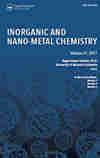Synthesis and Structural Properties of Nanoselenium-Supported MCM-41 Material
Synthesis and Reactivity in Inorganic, Metal-Organic, and Nano-Metal Chemistry
Pub Date : 2016-05-03
DOI:10.1080/15533174.2014.989579
引用次数: 2
Abstract
The authors describe herein a new process for the synthesis of nanoselenium–supported MCM-41 hybrid material. Selenium nanoparticles were synthesized via chemical reduction method that this method is capable of producing spherical selenium nanoparticles of size 20 to 80 nm, under ambient conditions, and covalently bonded to MCM-41 framework by 3-(triethoxysilyl)-propylamine (APTES). The structures, morphology and size of the products were investigated by several characterization techniques such as XRD, SEM, TEM, FT-IR, UV–vis/DRS, Raman spectroscopy, and N2 adsorption–desorption isotherms method. These results demonstrated that Se-MCM-41 is a promising candidate for biosensor, adsorbent, or catalyst.纳米硒负载MCM-41材料的合成及结构性能研究
本文介绍了一种合成纳米硒负载MCM-41杂化材料的新工艺。采用化学还原法制备了硒纳米粒子,该方法在常温条件下可制得尺寸为20 ~ 80 nm的球形硒纳米粒子,并通过3-(三乙氧基硅基)-丙胺(APTES)与MCM-41骨架共价键合。采用XRD、SEM、TEM、FT-IR、UV-vis /DRS、拉曼光谱、N2吸附-脱附等温线等表征技术对产物的结构、形貌和粒径进行了表征。这些结果表明Se-MCM-41是一种很有前途的生物传感器、吸附剂或催化剂的候选者。
本文章由计算机程序翻译,如有差异,请以英文原文为准。
求助全文
约1分钟内获得全文
求助全文
来源期刊
自引率
0.00%
发文量
0
审稿时长
5 months

 求助内容:
求助内容: 应助结果提醒方式:
应助结果提醒方式:


